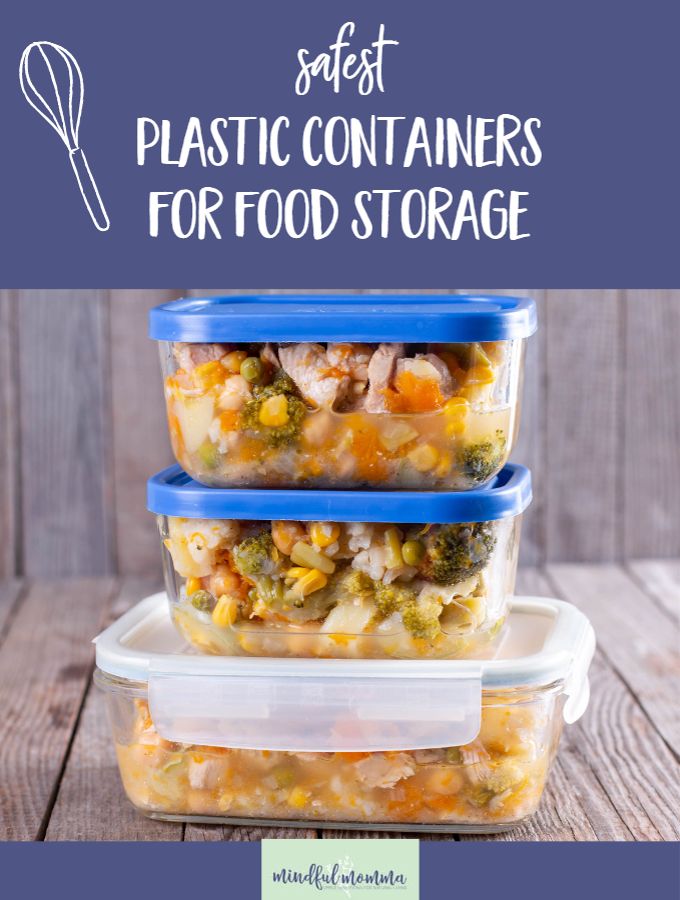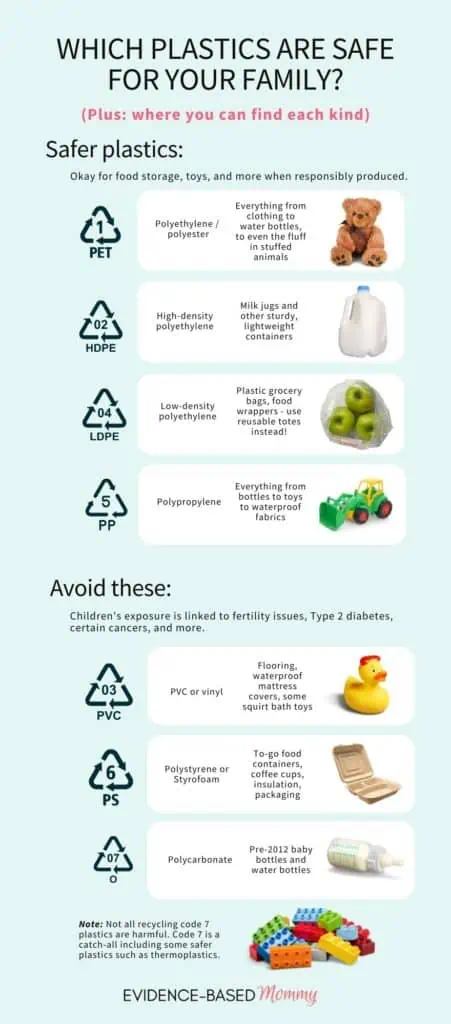The Safest Plastic For Food Storage Because Sometimes You Just Need It
Learn how to identify safe plastic food storage containers to store leftovers, and avoid plastics that contain toxic BPA and phthalates.

Note: You probably know, I’m a big advocate of going plastic-free whenever possible – but let’s be real – sometimes you just need the easy and cheap solution. That’s why I was happy to have an environmental chemist, Dr. Samantha Radford write this guest post about safer plastics.
Are you looking for a safe way to store your food? You know glass is safest, but it’s also breakable and heavier. That’s why we often want safe plastic food storage.
As you know, plastic is everywhere, from your yogurt cups to your baby’s crib mattress. While we can’t completely avoid plastic, we can choose the safest ones to protect ourselves and our kids.
Plus, let’s be real: We’ve probably all been handed down vintage Tupperware from our mom or grandma. Is it worse to use old plastic storage containers, or to throw them away and add to the waste problem?
In this post, I’ve asked my friend Dr. Samantha Radford, an environmental chemist, to recommend some safe plastic food storage containers for you to use. We will also provide tips on how to choose the right one for your needs. So, whether you are looking for a container to store leftovers or something to pack your lunch in, we have you covered!
At Mindful Momma we only endorse products we’ve personally researched, tested, and honestly love. We may receive commissions from affiliate links in this article including Amazon Affiliates. Full Disclosure
Safe Plastics for Food Storage
When it comes to storing food, not all plastics are created equal. Your primary goal is to avoid plasticizers. These chemicals, such as phthalates and bisphenols (BPA and BPS) are used to make certain plastics more flexible and durable, but they come with a price.
Plasticizers are hormone disruptors and have potential long-term toxic health effects. They have been linked to increased blood pressure, fertility issues in both men and women, Type 2 diabetes, and even some cancers.
Plasticizers are primarily used in the following plastic types: PVC (recycling code 3), Styrofoam (recycling code 6), and polycarbonate (some recycling code 7). Make sure you don’t use old polycarbonate food storage, and avoid styrofoam for your coffee or your child’s hot chocolate.
Fortunately, there are several types of plastic that are safe for food storage and do not pose any health risks. These include polypropylene, PET (also known as PETE or PETE), and HDPE (high-density polyethylene). These plastics are non-toxic, BPA and phthalate free, making them a safe choice for storing leftovers or packing lunch.
Not sure what type of plastic your container is? Look for the recycling symbol on the bottom – it will tell you what you need to know.

Polypropylene
Polypropylene (Recycling code 5) is one of the safest plastics and is best for food storage. It can be opaque or translucent depending on how it’s made.
Polypropylene is what is most commonly sold now when you buy plastic food storage containers. Its high melting point makes it dishwasher safe, and its durability makes it popular for long-term use.
PETE
Polyethylene terephthalate (PET or PETE, recycling code 1) is what’s commonly used for single use water or soda bottles. It’s also used for the clear containers you may get for soups for takeout.
While PET is much easier to recycle than polypropylene, it is also less durable and heat resistant. It’s not suitable for the dishwasher or microwave, so you’ll probably want to recycle it (instead of reusing) after you finish your takeout.
Tritan
Tritan is a newer, completely clear plastic that is rigid yet shatterproof. While there was some controversy over it in 2011 where a competing company claimed it had estrogenic activity, there has never been any research validating this claim. So make your own choice on whether to use Tritan.
With that said, Tritan is free of bisphenols, dishwasher safe, and won’t stain or haze over time like some plastics do.

Tips for Using Plastic Containers
When it comes to plastic containers, there are a few tips and precautions that can help extend their lifespan and keep your food safe.
Ditch old plastic food storage and bottles
Older food tubs and baby bottles are likely made with polycarbonate, which contains BPA. Here’s some dates you should know:
- Steer clear of baby bottles manufactured before 2013, as this is the year that the FDA banned BPA in bottles and sippy cups in the US.
- Tupperware made before 2010 may be made with polycarbonate, which can contain BPA or its relation BPS. As a result, it’s best to pitch any old plastic containers and opt for newer ones that don’t have these potential health hazards.
- Rubbermaid made before 2010 may also be made with polycarbonate. It’s best to get rid of any of their containers made before then.
Be careful what you store in plastic
It’s also important to pay attention to the types of liquids being stored in plastic containers. Acidic liquids like lemon juice and tomato sauce can cause chemicals to leach out of plastic, so it’s better to use glass jars or bowls for these items.
Similarly, cream-based liquids like potato soup should not be stored in plastic containers. That’s because these foods are lipophilic (fat-loving) so bisphenols and phthalates can easily leach into them.
Use your plastic bowls for storage, not reheating
Don’t microwave any foods in plastic – make sure you transfer the food to a plate or bowl first.
By following these guidelines, you can enjoy the convenience of using plastic containers while maximizing safety and longevity.
RELATED: Recommended Compostable Bags
Are Plastics Dishwasher Safe?
In an ideal world, you wouldn’t put plastic storage bowls in the dishwasher. However, we all know how it goes – no one has time to hand wash all their bowls!
Washing your storage containers in the dishwasher is safer than microwaving food in them though. That’s because in the dishwasher, you’re not leaving anything in contact with the plastic for a significant amount of time – the water sprays on and drips off. But in the microwave, you’re leaving your food in contact with the plastic wall as it heats up, allowing leachates to move into your food.
If you do choose to hand wash your plastic storage containers, make sure you use a gentle sponge or cloth. A harsh scrubber can easily scratch your containers, which can make it easier for chemicals to leach out.
Conclusions
With a little research and forethought, you can safely use plastic containers for food storage. Use the tips we’ve provided in this article to guide your choices when it comes to selecting safe plastic containers for food storage. And as always, if you have any questions or concerns please don’t hesitate to reach out – we’re here to help!
Need a product recommendation? This set of plastic food storage containers from OXO is made from durable polypropylene with leakproof lids. If you’re up for switching to more sustainable, plastic-free containers for food storage, check out my blog post on favorite reusable containers.



Fantastic write up!